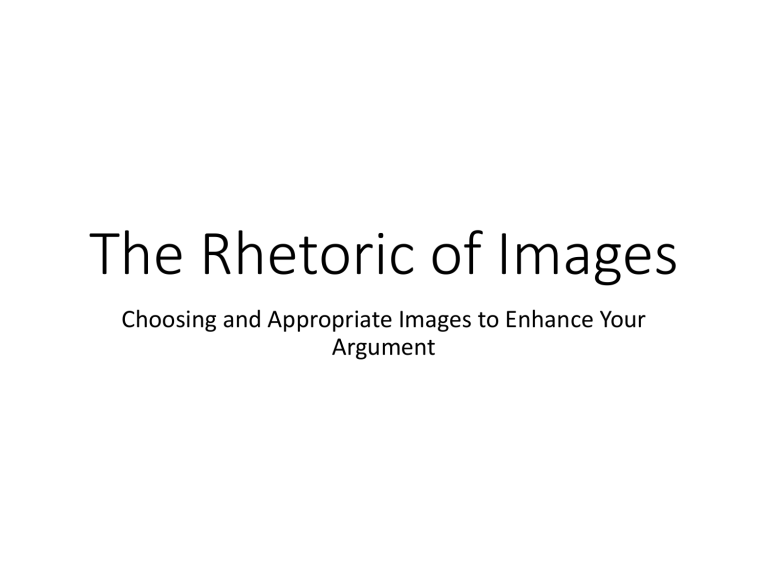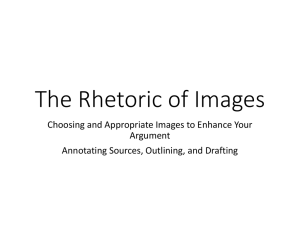3/12 Notes: The Rhetoric of Images, Using Images in MLA Format

The Rhetoric of Images
Choosing and Appropriate Images to Enhance Your
Argument
Choosing Images as a Rhetorical
Choice
• Remember, your rhetorical choices are the choices you make as a writer in order to communicate clearly and persuasively with your audience.
• A well-chosen image will illustrate or clarify a point made in the essay.
• A well-chosen image will be consistent with the tone and purpose of the essay.
• A well-chosen image will be given appropriate credit in your essay.
Examining Image Use
• In order to effectively use images in our own essays, we are going to examine how images are used to communicate in some example texts.
• See p. 30 of Mirror on America for a list of questions we will ask about each image.
• Since we read “Mickey Mouse as Cultural Icon,” I’ve selected several examples of visual rhetoric that are
Disney-related.
Image 1:
Image in context at: http://disneyparks.disney.go.com/orlando-vacations/
Analyzing the image:
Where is your eye drawn first in this image?
What is the main focus? What is pushed to the background?
What messages might this image communicate?
Image 2:
Image in context at: https://disneyland.disney.go.com/au/
Analyzing the image:
Where is your eye drawn first in this image?
What is the main focus?
What messages might this image communicate?
How is this image different than the first? How is its message different?
MLA Rules to Remember for
Citing Images
• Give credit for the image to the person who created it, if you know who that was.
• Let your audience know where to find the image if they want to see it for themselves in context.
• Unlike other essays where I have allowed you to insert images without referring to them, you MUST mention each image you use in the text of your paper.
Tips for Choosing Images for Use in Your Essay (via the OWL)
• Choose images that are directly relevant to the
argument you are making. Look for illustrations that enhance your audience’s understanding of your topic or illustrate a point you are trying to make in a powerful way.
• Use quality versions of the images. If your images are low quality or distorted, this distracts your reader from your argument.
How Do I Cite an Image?
• Each image will be assigned a number, in the order in which it is mentioned in the essay.
• In MLA format, photographs, charts, graphs, and other images are all called “figures.” This is abbreviated in the text of your paper to “fig.”
• When you mention the image, direct your audience to that image at the end of the sentence that mentions it by writing (see fig. #) at the end. (Note: replace # sign by the number assigned to the image.)
How Do I Cite an Image?
• Each image must have a caption below it that does three things:
• Tells the image’s figure number.
• Briefly describes the image and why it is relevant to your argument.
• Gives credit to the source of the image, either with an in-text citation (author’s name in parentheses) if the source is on your works cited page, or by simply telling the audience all information about the source of the image in the caption.
Example Image Use When You
Know the Photographer/Creator
• The following example uses an image from an article called “ 'Required Reading': As Textbook
Prices Soar, Students Try to Cope ”
• Here is how you might mention the image in the body of your essay.
The high price of textbooks is especially tough for bright students who are pushing themselves academically. Students who double major in difficult fields find themselves paying even more for textbooks than their peers with a single major (see fig. 1).
Insert the image at the end of the paragraph where you mention it. Try to center the image.
Fig. 1: A student who is majoring in pre-med, biology, and Spanish sits next to a few of her textbooks. Photograph by John Breecher for the article “'Required Reading': As
Textbook Prices Soar, Students Try to Cope” by Martha C. White.
Example Image Use With Example
Disney Image:
• in the body of your essay.
In many of the advertisements on Disney’s website, the iconic Disney landmarks are pushed to the background. The focus in these images is often several generations of a smiling family (see fig. 1).
Kids ride on their parents’ shoulders, grandparents hold hands with grandchildren, and in the background, small but not forgotten, the Disney castle reminds the audience which company is responsible for this perfect moment of family bonding.
Insert the image at the end of the paragraph where you mention it. Try to center the image.
Fig. 1: A Disney World advertisement features a family standing on Main Street with the castle in the background. Image retrieved from the “Orlando Family Vacations” section of the official Disney Parks website.
General Guidelines:
• Give your audience enough information in the caption to find the image for themselves.
• If you can’t find the name of a photographer or creator, leave it out, but give your audience some other information to help them find the image.
• Use google image search to see if you can find a copy of the image accompanied by more information.
(images.google.com) Simply drag and drop the image you want more information about into the search bar, and it will find similar images and give you any information google can find about it.
Do I HAVE TO have an image in my essay?
• No, but images are incredibly powerful rhetorical tools.
• You will want to consider whether your argument would be strengthened by including at least an image or two that were relevant to your main points.
• I will not take away points if you do not have images, but excellent use of images can help you to
earn more points in categories where I am grading you on use of rhetorical tools.
Goals for today:
• Listen to your voice comments, if you have them.
• Revise your essay. From what I saw, many of you have good early drafts, but there needs to be a lot of work put in before they are ready to turn in.
• View the rubric I will use to grade you on turnitin.
Ask questions if you are unsure of my expectations.
• Find and incorporate a rhetorically appropriate image into your essay.

